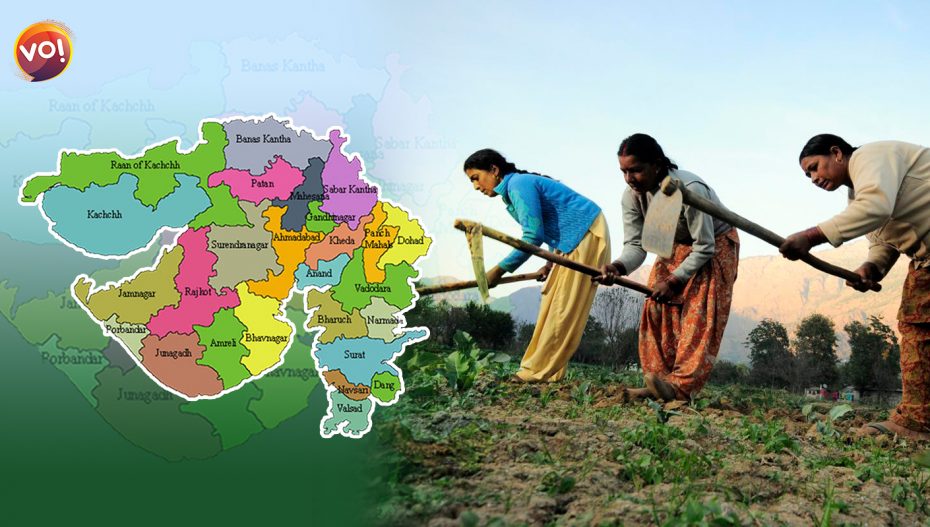In Gujarat the basic social and economic protection is missing for a large portion of the rural population, this is the reason women fall back on agriculture. Agriculture is also the cheapest and weakest form of labour in households. As per the information collected in Agriculture Census 2015-16, about 11.72% of the total operated area in the country was operated by female operational holders. While in Gujarat there are 4440,000 male farmers in comparison to 877,000 women farmers into agriculture land holding. It amounts to 83.50% male while only 16.49% women land holders.
In other States the gender gap is equally visible. Maharashtra has 12, 894,000 male farmers as land holders while just 23,64,000 women land holders. In a State such as Punjab where agriculture is the main source of income for most people, the male to female ratio in agricultural land holding is 1074: 17.
As per the 2011 Census, only 10 percent of women in Gujarat owned land. However, during the house-listing exercise of 3,225 houses in the four surveyed districts, it was found that only three per cent of women owned land. Out of this three per cent, 1.3 per cent did not know that the land ownership was under their names.
Wage Gap
Another troubling issue is the wage gap. With further widening the gender gap, the number of hours spent by women farmers in Gujarat working in fields has increased, while their wages have decreased. The opposite is, however, true for male farmers, according to a study funded by Indian Council of Social Science Research (ICSSR) and Australian Research Council (ARC).
The National Crime Records Bureau (NCRB) under the Ministry of Home Affairs compiles and disseminates information on suicides in its publication titled ‘Accidental Deaths and Suicides in India’. As per the publication, the term ‘Farmer’ is defined as “the Person whose profession is farming and includes those who cultivate on their own land as well as those who cultivate on leased land/other’s land with or without the assistance of agricultural labourers”.
State-wise number of female and male operational holders.
As per the results of the Situation Assessment Survey (SAS) of Agricultural Households and Land and Livestock Holdings of Households in Rural India- 2019 conducted by National Statistical Office(NSO) for the agriculture year July 2018-June 2019.
| State-wise estimated number of female and male operational holders as per Agriculture Census 2015-16 | ||||
| Sl. No. | States/Uts | Female | Male | |
| Number (in ‘000) | Number(in ‘000) | |||
| 1 | A & N Islands | 4 | 8 | |
| 2 | Andhra Pradesh | 2565 | 5955 | |
| 3 | Arunachal Pradesh | 14 | 97 | |
| 4 | Assam | 46 | 2691 | |
| 5 | Bihar | 2297 | 14090 | |
| 6 | Chandigarh | Neg | 1 | |
| 7 | Chhattisgarh | 553 | 3457 | |
| 8 | D & N Haveli | 3 | 12 | |
| 9 | Daman & Diu | 2 | 6 | |
| 10 | Delhi | 3 | 17 | |
| 11 | Goa | 19 | 55 | |
| 12 | Gujarat | 877 | 4440 | |
| 13 | Haryana | 240 | 1371 | |
| 14 | Himachal Pradesh | 74 | 922 | |
| 15 | Jammu & Kashmir | 108 | 1307 | |
| 16 | Jharkhand | 316 | 2483 | |
| 17 | Karnataka | 1743 | 6919 | |
| 18 | Kerala | 1742 | 5778 | |
| 19 | Lakshadweep | 4 | 5 | |
| 20 | Madhya Pradesh | 1189 | 8808 | |
| 21 | Maharashtra | 2364 | 12894 | |
| 22 | Manipur | 10 | 140 | |
| 23 | Meghalaya | 80 | 152 | |
| 24 | Mizoram | 11 | 79 | |
| 25 | Nagaland | 19 | 177 | |
| 26 | Odisha | 198 | 4667 | |
| 27 | Puducherry | 8 | 26 | |
| 28 | Punjab | 17 | 1074 | |
| 29 | Rajasthan | 775 | 6866 | |
| 30 | Sikkim | 5 | 66 | |
| 31 | Tamil Nadu | 1560 | 6350 | |
| 32 | Telangana | 1368 | 4579 | |
| 33 | Tripura | 71 | 502 | |
| 34 | Uttar Pradesh | 1824 | 21972 | |
| 35 | Uttarakhand | 105 | 775 | |
| 36 | West Bengal | 230 | 7008 | |
| All India | 20439 | 125751 |









